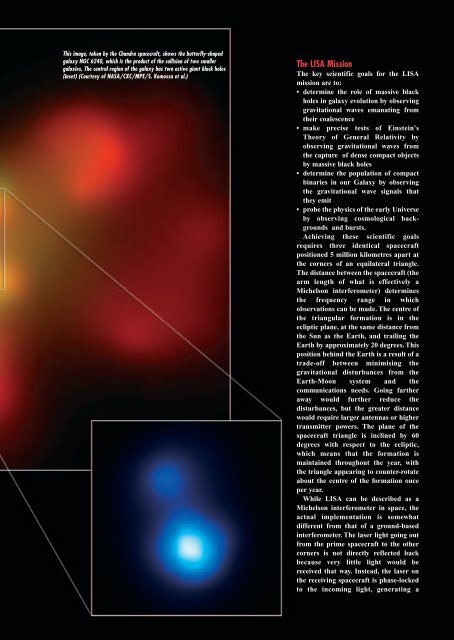Gravitational Waves and Massive Black Holes? – The LISA
Gravitational Waves and Massive Black Holes? – The LISA
Gravitational Waves and Massive Black Holes? – The LISA
Create successful ePaper yourself
Turn your PDF publications into a flip-book with our unique Google optimized e-Paper software.
This image, taken by the Ch<strong>and</strong>ra spacecraft, shows the butterfly-shaped<br />
galaxy NGC 6240, which is the product of the collision of two smaller<br />
galaxies. <strong>The</strong> central region of the galaxy has two active giant black holes<br />
(inset) (Courtesy of NASA/CXC/MPE/S. Komossa et al.)<br />
<strong>The</strong> <strong>LISA</strong> Mission<br />
<strong>The</strong> key scientific goals for the <strong>LISA</strong><br />
mission are to:<br />
• determine the role of massive black<br />
holes in galaxy evolution by observing<br />
gravitational waves emanating from<br />
their coalescence<br />
• make precise tests of Einstein's<br />
<strong>The</strong>ory of General Relativity by<br />
observing gravitational waves from<br />
the capture of dense compact objects<br />
by massive black holes<br />
• determine the population of compact<br />
binaries in our Galaxy by observing<br />
the gravitational wave signals that<br />
they emit<br />
• probe the physics of the early Universe<br />
by observing cosmological backgrounds<br />
<strong>and</strong> bursts.<br />
Achieving these scientific goals<br />
requires three identical spacecraft<br />
positioned 5 million kilometres apart at<br />
the corners of an equilateral triangle.<br />
<strong>The</strong> distance between the spacecraft (the<br />
arm length of what is effectively a<br />
Michelson interferometer) determines<br />
the frequency range in which<br />
observations can be made. <strong>The</strong> centre of<br />
the triangular formation is in the<br />
ecliptic plane, at the same distance from<br />
the Sun as the Earth, <strong>and</strong> trailing the<br />
Earth by approximately 20 degrees. This<br />
position behind the Earth is a result of a<br />
trade-off between minimising the<br />
gravitational disturbances from the<br />
Earth-Moon system <strong>and</strong> the<br />
communications needs. Going farther<br />
away would further reduce the<br />
disturbances, but the greater distance<br />
would require larger antennas or higher<br />
transmitter powers. <strong>The</strong> plane of the<br />
spacecraft triangle is inclined by 60<br />
degrees with respect to the ecliptic,<br />
which means that the formation is<br />
maintained throughout the year, with<br />
the triangle appearing to counter-rotate<br />
about the centre of the formation once<br />
per year.<br />
While <strong>LISA</strong> can be described as a<br />
Michelson interferometer in space, the<br />
actual implementation is somewhat<br />
different from that of a ground-based<br />
interferometer. <strong>The</strong> laser light going out<br />
from the prime spacecraft to the other<br />
corners is not directly reflected back<br />
because very little light would be<br />
received that way. Instead, the laser on<br />
the receiving spacecraft is phase-locked<br />
to the incoming light, generating a

















